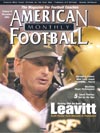AMERICAN FOOTBALL MONTHLY THE #1 RESOURCE FOR FOOTBALL COACHES
Article CategoriesAFM Magazine
|
Running with the Bulls...Jim Leavitt and South Florida: From obscurity to prominence in just six yearsby: Aaron S. Lee © More from this issue EDITOR'S NOTE: On Dec. 12, 2002, Jim Leavitt signed a new five-year contract with a total base salary worth $2.4 million. The salary escalates from $407,173 in 2003 to $596,143 in 2007, the final year of the contract. Leavitt had been under contract through 2005. In addition to base salary, the new contract includes a $25,000 annual annuity and television/radio money that escalates from $40,000 to $50,000 over the course of the five years. With a base salary of $140,000, South Florida's Jim Leavitt may in fact be the best bargain in college football, but one thing is for certain he is no longer a secret. The University of South Florida had better ante up soon because Leavitt is on the national radar screen....The full article can only be seen by subscribers. Subscribe today!
|
|
|||||||
| HOME |
MAGAZINE |
SUBSCRIBE | ONLINE COLUMNISTS | COACHING VIDEOS |
Copyright 2025, AmericanFootballMonthly.com
All Rights Reserved





